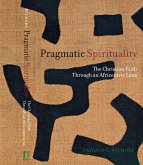- Broschiertes Buch
- Merkliste
- Auf die Merkliste
- Bewerten Bewerten
- Teilen
- Produkt teilen
- Produkterinnerung
- Produkterinnerung
Marla F. Frederick is Professor of African and African American Studies and of the Study of Religion at Harvard University.
Andere Kunden interessierten sich auch für
![An Ex-Colored Church: Cme Church An Ex-Colored Church: Cme Church]() Raymond R. SommervilleAn Ex-Colored Church: Cme Church36,99 €
Raymond R. SommervilleAn Ex-Colored Church: Cme Church36,99 €![Little Mosque on the Prairie and the Paradoxes of Cultural Translation Little Mosque on the Prairie and the Paradoxes of Cultural Translation]() Kyle ConwayLittle Mosque on the Prairie and the Paradoxes of Cultural Translation48,99 €
Kyle ConwayLittle Mosque on the Prairie and the Paradoxes of Cultural Translation48,99 €![Pragmatic Spirituality Pragmatic Spirituality]() Gayraud S WilmorePragmatic Spirituality39,99 €
Gayraud S WilmorePragmatic Spirituality39,99 €![Resurrection Song Resurrection Song]() Flora Wilson BridgesResurrection Song22,99 €
Flora Wilson BridgesResurrection Song22,99 €![The Lure of Images The Lure of Images]() David MorganThe Lure of Images63,99 €
David MorganThe Lure of Images63,99 €![African-American Religion African-American Religion]() Timothy E. Fulop / Albert J. Raboteau (eds.)African-American Religion58,99 €
Timothy E. Fulop / Albert J. Raboteau (eds.)African-American Religion58,99 €![A Womanist Theology of Worship A Womanist Theology of Worship]() Lisa AllenA Womanist Theology of Worship24,99 €
Lisa AllenA Womanist Theology of Worship24,99 €-
-
-
Marla F. Frederick is Professor of African and African American Studies and of the Study of Religion at Harvard University.
Hinweis: Dieser Artikel kann nur an eine deutsche Lieferadresse ausgeliefert werden.
Hinweis: Dieser Artikel kann nur an eine deutsche Lieferadresse ausgeliefert werden.
Produktdetails
- Produktdetails
- Verlag: Stanford University Press
- Seitenzahl: 256
- Erscheinungstermin: 16. Dezember 2015
- Englisch
- Abmessung: 226mm x 152mm x 15mm
- Gewicht: 318g
- ISBN-13: 9780804796989
- ISBN-10: 080479698X
- Artikelnr.: 42791301
- Herstellerkennzeichnung
- Produktsicherheitsverantwortliche/r
- Europaallee 1
- 36244 Bad Hersfeld
- gpsr@libri.de
- Verlag: Stanford University Press
- Seitenzahl: 256
- Erscheinungstermin: 16. Dezember 2015
- Englisch
- Abmessung: 226mm x 152mm x 15mm
- Gewicht: 318g
- ISBN-13: 9780804796989
- ISBN-10: 080479698X
- Artikelnr.: 42791301
- Herstellerkennzeichnung
- Produktsicherheitsverantwortliche/r
- Europaallee 1
- 36244 Bad Hersfeld
- gpsr@libri.de
Marla F. Frederick is Professor of African and African American Studies and of the Study of Religion at Harvard University.
Contents and Abstracts
Introduction
chapter abstract
The introduction includes a statement on the methodology used to complete
this ethnography as well as an outline of individual chapters. It further
highlights the three theoretical interventions of this text. These include
firstly, the insistence that the web of religious broadcasting cannot be
understood without a full appreciation of the aims, motivations and desires
of all those involved - producers, consumers and distributors. Secondly,
Colored Television takes seriously the discourse of intersectionality,
arguing that the issues of race, class and gender explored in this book
help explain elements present in the rise of both gospels of prosperity and
increasingly important discourses around sexuality. Finally, while not
reducing religion solely to market forces, this work argues that the
business of broadcasting fundamentally alters religion and the experiences
of the faithful.
1"Jamaica, Land We Love"
chapter abstract
Chapter one frames the discussion of religious broadcasting in terms of
globalization, neoliberalism and the history of American religious media.
Exploring briefly the history of African American religious missions, it
argues that religious globalization is not new. However, in the
hyper-mediated form of religious broadcasting, new elements of
globalization, more resonate with neoliberal market logics, take
precedence. In articulating these moves, the chapter outlines the history
of American religious broadcasting, explaining the significance of the
switch to paid time broadcasting that ultimately catapulted religious
broadcasting into the world of religious media competition.
2"Religious Dandyism: Prosperity and Performance in Black Televangelism"
chapter abstract
Given the emergence of popular images of televangelists as wealthy,
status-driven media personalities who embody the prototypical,
rags-to-riches American success story, Chapter Two explores the history of
the emergence African Americans as televangelists. The chapter argues that
race and American racism played as much a part in the development of these
character types as the theologies of Word of Faith or neo-Pentecostal
personalities. In many ways the presentation of "Americanness" through the
acquisition of the American dream - fine cars, tailored suits, lavish
lifestyles - provided an image of racial uplift that was missing from black
protest religion. The story of Rev. Frederick Eikenrenkoetter and other
leading black televangelists contextualize the ways in which the flamboyant
dress style, or "religious dandyism" of ministers was as much about
creating a narrative of possibility for colored people as it was about the
fashion and egoism of the preacher.
3"Relative Prosperity: Lived Religion in the "Dying Field"
chapter abstract
Chapter three explores how American theologies of prosperity are
appropriated by viewers in Jamaica. As neoliberalism exports the utopian
ideal of the "free market" to countries around the globe, developing
countries are often confined by the realities of their local often
underdeveloped and/or exploited (exploitable) markets. Living under
challenging economic pressures, local Jamaicans make sense of imported
gospels of prosperity by developing more complicated, relative
understandings of the nature of prosperity. Those in the viewing audience
who receive messages of health and wealth in the face of poverty and
affliction often interpret prosperity as relative in terms of time, space
and constitution.
4"Female Televangelists and the Gospel of Sexual Redemption"
chapter abstract
Chapter four looks at the phenomenal influence of women televangelists. It
argues that women's ascendance in religious broadcasting is often
influenced by their personal testimonies of sexual trauma and God's power
to redeem and restore their lives. Their "gospels of sexual redemption"
recalling experiences of rape, incest, early pregnancy, divorce and sexual
promiscuity opens up important, though limited, discursive space for the
discussion of sexuality among female religious viewers. The chapter
discusses evangelists Paula White and Joyce Meyer, giving particular
attention to the influence of Juanita Bynum, an African American woman
whose testimony of abuse and sexual promiscuity garnered her tremendous
popularity in the US and abroad.
5Redeeming Sexuality
chapter abstract
Chapter five examines how the social and economic conditions in which
Jamaican women find themselves often inform their experiences of sexuality.
These experiences in turn influence how women relate to the messages of
sexual redemption preached by televangelists. The chapter argues that while
religious broadcasting offers a conservative approach to the practice of
sexuality, confining sexual activity to marriage and offering a masculinist
narrative of female submission to male authority, it also offers women an
opportunity to redefine their sexual histories and make sense of personal
tragedy. For women from traditional religious backgrounds, the personal
theodicies of women evangelists who share their stories of abuse, out of
wedlock childbirth and sexual promiscuity offer viewers opportunities to
recast their own sexual histories in light of redemptive narratives.
6"Distributing the Message: Globalization and the Spread of Black
Televangelism"
chapter abstract
Chapter six explores the power of distributors and the meanings of race in
the global market. Scholars of religious broadcasting have long discussed
the influence of politically and theologically conservative Trinity
Broadcasting Network (TBN), the largest religious cable network in the
world. This chapter explores the emergence of black owned networks and
networks which cater to "urban" African American markets, such as TV One in
the United States and Mercy and Truth Ministries and Love TV in Jamaica,
which make room for a different kind of religious broadcasting format,
presumably informed by different social commitments. It asks how these new
outlets for religious broadcasting negotiate the demands of the neoliberal
marketplace and attempt to create an alternative vision of the intersection
of religion and the market in a post-civil rights, post-apartheid,
post-colonialist historical moment.
7"Conclusion: Voices of the Next Generation"
chapter abstract
The Conclusion focuses on the increasing influence of the Internet, over
and against religious television broadcasting. Here questions are raised as
to how the emergence of the Internet, like the shift to paid time
broadcasting in the 1960s, might ultimately reshape religious broadcasting.
Focused on the success of a ministry in Atlanta, Ga that has grown largely
through internet broadcasting, the final chapter wonders whether, given the
changes in technology, whether the the contours of what we have come to
understand as popular religion will eventually shift to something that
moves beyond prosperity messages and self help proclamations? As the
democratization of religious media through the internet and social media
sites takes full shape, it is likely that popular religious media
narratives will be disrupted by people from across the globe and the
theological spectrum, not just those savvy and wealthy enough to survive on
religious television.
Introduction
chapter abstract
The introduction includes a statement on the methodology used to complete
this ethnography as well as an outline of individual chapters. It further
highlights the three theoretical interventions of this text. These include
firstly, the insistence that the web of religious broadcasting cannot be
understood without a full appreciation of the aims, motivations and desires
of all those involved - producers, consumers and distributors. Secondly,
Colored Television takes seriously the discourse of intersectionality,
arguing that the issues of race, class and gender explored in this book
help explain elements present in the rise of both gospels of prosperity and
increasingly important discourses around sexuality. Finally, while not
reducing religion solely to market forces, this work argues that the
business of broadcasting fundamentally alters religion and the experiences
of the faithful.
1"Jamaica, Land We Love"
chapter abstract
Chapter one frames the discussion of religious broadcasting in terms of
globalization, neoliberalism and the history of American religious media.
Exploring briefly the history of African American religious missions, it
argues that religious globalization is not new. However, in the
hyper-mediated form of religious broadcasting, new elements of
globalization, more resonate with neoliberal market logics, take
precedence. In articulating these moves, the chapter outlines the history
of American religious broadcasting, explaining the significance of the
switch to paid time broadcasting that ultimately catapulted religious
broadcasting into the world of religious media competition.
2"Religious Dandyism: Prosperity and Performance in Black Televangelism"
chapter abstract
Given the emergence of popular images of televangelists as wealthy,
status-driven media personalities who embody the prototypical,
rags-to-riches American success story, Chapter Two explores the history of
the emergence African Americans as televangelists. The chapter argues that
race and American racism played as much a part in the development of these
character types as the theologies of Word of Faith or neo-Pentecostal
personalities. In many ways the presentation of "Americanness" through the
acquisition of the American dream - fine cars, tailored suits, lavish
lifestyles - provided an image of racial uplift that was missing from black
protest religion. The story of Rev. Frederick Eikenrenkoetter and other
leading black televangelists contextualize the ways in which the flamboyant
dress style, or "religious dandyism" of ministers was as much about
creating a narrative of possibility for colored people as it was about the
fashion and egoism of the preacher.
3"Relative Prosperity: Lived Religion in the "Dying Field"
chapter abstract
Chapter three explores how American theologies of prosperity are
appropriated by viewers in Jamaica. As neoliberalism exports the utopian
ideal of the "free market" to countries around the globe, developing
countries are often confined by the realities of their local often
underdeveloped and/or exploited (exploitable) markets. Living under
challenging economic pressures, local Jamaicans make sense of imported
gospels of prosperity by developing more complicated, relative
understandings of the nature of prosperity. Those in the viewing audience
who receive messages of health and wealth in the face of poverty and
affliction often interpret prosperity as relative in terms of time, space
and constitution.
4"Female Televangelists and the Gospel of Sexual Redemption"
chapter abstract
Chapter four looks at the phenomenal influence of women televangelists. It
argues that women's ascendance in religious broadcasting is often
influenced by their personal testimonies of sexual trauma and God's power
to redeem and restore their lives. Their "gospels of sexual redemption"
recalling experiences of rape, incest, early pregnancy, divorce and sexual
promiscuity opens up important, though limited, discursive space for the
discussion of sexuality among female religious viewers. The chapter
discusses evangelists Paula White and Joyce Meyer, giving particular
attention to the influence of Juanita Bynum, an African American woman
whose testimony of abuse and sexual promiscuity garnered her tremendous
popularity in the US and abroad.
5Redeeming Sexuality
chapter abstract
Chapter five examines how the social and economic conditions in which
Jamaican women find themselves often inform their experiences of sexuality.
These experiences in turn influence how women relate to the messages of
sexual redemption preached by televangelists. The chapter argues that while
religious broadcasting offers a conservative approach to the practice of
sexuality, confining sexual activity to marriage and offering a masculinist
narrative of female submission to male authority, it also offers women an
opportunity to redefine their sexual histories and make sense of personal
tragedy. For women from traditional religious backgrounds, the personal
theodicies of women evangelists who share their stories of abuse, out of
wedlock childbirth and sexual promiscuity offer viewers opportunities to
recast their own sexual histories in light of redemptive narratives.
6"Distributing the Message: Globalization and the Spread of Black
Televangelism"
chapter abstract
Chapter six explores the power of distributors and the meanings of race in
the global market. Scholars of religious broadcasting have long discussed
the influence of politically and theologically conservative Trinity
Broadcasting Network (TBN), the largest religious cable network in the
world. This chapter explores the emergence of black owned networks and
networks which cater to "urban" African American markets, such as TV One in
the United States and Mercy and Truth Ministries and Love TV in Jamaica,
which make room for a different kind of religious broadcasting format,
presumably informed by different social commitments. It asks how these new
outlets for religious broadcasting negotiate the demands of the neoliberal
marketplace and attempt to create an alternative vision of the intersection
of religion and the market in a post-civil rights, post-apartheid,
post-colonialist historical moment.
7"Conclusion: Voices of the Next Generation"
chapter abstract
The Conclusion focuses on the increasing influence of the Internet, over
and against religious television broadcasting. Here questions are raised as
to how the emergence of the Internet, like the shift to paid time
broadcasting in the 1960s, might ultimately reshape religious broadcasting.
Focused on the success of a ministry in Atlanta, Ga that has grown largely
through internet broadcasting, the final chapter wonders whether, given the
changes in technology, whether the the contours of what we have come to
understand as popular religion will eventually shift to something that
moves beyond prosperity messages and self help proclamations? As the
democratization of religious media through the internet and social media
sites takes full shape, it is likely that popular religious media
narratives will be disrupted by people from across the globe and the
theological spectrum, not just those savvy and wealthy enough to survive on
religious television.
Contents and Abstracts
Introduction
chapter abstract
The introduction includes a statement on the methodology used to complete
this ethnography as well as an outline of individual chapters. It further
highlights the three theoretical interventions of this text. These include
firstly, the insistence that the web of religious broadcasting cannot be
understood without a full appreciation of the aims, motivations and desires
of all those involved - producers, consumers and distributors. Secondly,
Colored Television takes seriously the discourse of intersectionality,
arguing that the issues of race, class and gender explored in this book
help explain elements present in the rise of both gospels of prosperity and
increasingly important discourses around sexuality. Finally, while not
reducing religion solely to market forces, this work argues that the
business of broadcasting fundamentally alters religion and the experiences
of the faithful.
1"Jamaica, Land We Love"
chapter abstract
Chapter one frames the discussion of religious broadcasting in terms of
globalization, neoliberalism and the history of American religious media.
Exploring briefly the history of African American religious missions, it
argues that religious globalization is not new. However, in the
hyper-mediated form of religious broadcasting, new elements of
globalization, more resonate with neoliberal market logics, take
precedence. In articulating these moves, the chapter outlines the history
of American religious broadcasting, explaining the significance of the
switch to paid time broadcasting that ultimately catapulted religious
broadcasting into the world of religious media competition.
2"Religious Dandyism: Prosperity and Performance in Black Televangelism"
chapter abstract
Given the emergence of popular images of televangelists as wealthy,
status-driven media personalities who embody the prototypical,
rags-to-riches American success story, Chapter Two explores the history of
the emergence African Americans as televangelists. The chapter argues that
race and American racism played as much a part in the development of these
character types as the theologies of Word of Faith or neo-Pentecostal
personalities. In many ways the presentation of "Americanness" through the
acquisition of the American dream - fine cars, tailored suits, lavish
lifestyles - provided an image of racial uplift that was missing from black
protest religion. The story of Rev. Frederick Eikenrenkoetter and other
leading black televangelists contextualize the ways in which the flamboyant
dress style, or "religious dandyism" of ministers was as much about
creating a narrative of possibility for colored people as it was about the
fashion and egoism of the preacher.
3"Relative Prosperity: Lived Religion in the "Dying Field"
chapter abstract
Chapter three explores how American theologies of prosperity are
appropriated by viewers in Jamaica. As neoliberalism exports the utopian
ideal of the "free market" to countries around the globe, developing
countries are often confined by the realities of their local often
underdeveloped and/or exploited (exploitable) markets. Living under
challenging economic pressures, local Jamaicans make sense of imported
gospels of prosperity by developing more complicated, relative
understandings of the nature of prosperity. Those in the viewing audience
who receive messages of health and wealth in the face of poverty and
affliction often interpret prosperity as relative in terms of time, space
and constitution.
4"Female Televangelists and the Gospel of Sexual Redemption"
chapter abstract
Chapter four looks at the phenomenal influence of women televangelists. It
argues that women's ascendance in religious broadcasting is often
influenced by their personal testimonies of sexual trauma and God's power
to redeem and restore their lives. Their "gospels of sexual redemption"
recalling experiences of rape, incest, early pregnancy, divorce and sexual
promiscuity opens up important, though limited, discursive space for the
discussion of sexuality among female religious viewers. The chapter
discusses evangelists Paula White and Joyce Meyer, giving particular
attention to the influence of Juanita Bynum, an African American woman
whose testimony of abuse and sexual promiscuity garnered her tremendous
popularity in the US and abroad.
5Redeeming Sexuality
chapter abstract
Chapter five examines how the social and economic conditions in which
Jamaican women find themselves often inform their experiences of sexuality.
These experiences in turn influence how women relate to the messages of
sexual redemption preached by televangelists. The chapter argues that while
religious broadcasting offers a conservative approach to the practice of
sexuality, confining sexual activity to marriage and offering a masculinist
narrative of female submission to male authority, it also offers women an
opportunity to redefine their sexual histories and make sense of personal
tragedy. For women from traditional religious backgrounds, the personal
theodicies of women evangelists who share their stories of abuse, out of
wedlock childbirth and sexual promiscuity offer viewers opportunities to
recast their own sexual histories in light of redemptive narratives.
6"Distributing the Message: Globalization and the Spread of Black
Televangelism"
chapter abstract
Chapter six explores the power of distributors and the meanings of race in
the global market. Scholars of religious broadcasting have long discussed
the influence of politically and theologically conservative Trinity
Broadcasting Network (TBN), the largest religious cable network in the
world. This chapter explores the emergence of black owned networks and
networks which cater to "urban" African American markets, such as TV One in
the United States and Mercy and Truth Ministries and Love TV in Jamaica,
which make room for a different kind of religious broadcasting format,
presumably informed by different social commitments. It asks how these new
outlets for religious broadcasting negotiate the demands of the neoliberal
marketplace and attempt to create an alternative vision of the intersection
of religion and the market in a post-civil rights, post-apartheid,
post-colonialist historical moment.
7"Conclusion: Voices of the Next Generation"
chapter abstract
The Conclusion focuses on the increasing influence of the Internet, over
and against religious television broadcasting. Here questions are raised as
to how the emergence of the Internet, like the shift to paid time
broadcasting in the 1960s, might ultimately reshape religious broadcasting.
Focused on the success of a ministry in Atlanta, Ga that has grown largely
through internet broadcasting, the final chapter wonders whether, given the
changes in technology, whether the the contours of what we have come to
understand as popular religion will eventually shift to something that
moves beyond prosperity messages and self help proclamations? As the
democratization of religious media through the internet and social media
sites takes full shape, it is likely that popular religious media
narratives will be disrupted by people from across the globe and the
theological spectrum, not just those savvy and wealthy enough to survive on
religious television.
Introduction
chapter abstract
The introduction includes a statement on the methodology used to complete
this ethnography as well as an outline of individual chapters. It further
highlights the three theoretical interventions of this text. These include
firstly, the insistence that the web of religious broadcasting cannot be
understood without a full appreciation of the aims, motivations and desires
of all those involved - producers, consumers and distributors. Secondly,
Colored Television takes seriously the discourse of intersectionality,
arguing that the issues of race, class and gender explored in this book
help explain elements present in the rise of both gospels of prosperity and
increasingly important discourses around sexuality. Finally, while not
reducing religion solely to market forces, this work argues that the
business of broadcasting fundamentally alters religion and the experiences
of the faithful.
1"Jamaica, Land We Love"
chapter abstract
Chapter one frames the discussion of religious broadcasting in terms of
globalization, neoliberalism and the history of American religious media.
Exploring briefly the history of African American religious missions, it
argues that religious globalization is not new. However, in the
hyper-mediated form of religious broadcasting, new elements of
globalization, more resonate with neoliberal market logics, take
precedence. In articulating these moves, the chapter outlines the history
of American religious broadcasting, explaining the significance of the
switch to paid time broadcasting that ultimately catapulted religious
broadcasting into the world of religious media competition.
2"Religious Dandyism: Prosperity and Performance in Black Televangelism"
chapter abstract
Given the emergence of popular images of televangelists as wealthy,
status-driven media personalities who embody the prototypical,
rags-to-riches American success story, Chapter Two explores the history of
the emergence African Americans as televangelists. The chapter argues that
race and American racism played as much a part in the development of these
character types as the theologies of Word of Faith or neo-Pentecostal
personalities. In many ways the presentation of "Americanness" through the
acquisition of the American dream - fine cars, tailored suits, lavish
lifestyles - provided an image of racial uplift that was missing from black
protest religion. The story of Rev. Frederick Eikenrenkoetter and other
leading black televangelists contextualize the ways in which the flamboyant
dress style, or "religious dandyism" of ministers was as much about
creating a narrative of possibility for colored people as it was about the
fashion and egoism of the preacher.
3"Relative Prosperity: Lived Religion in the "Dying Field"
chapter abstract
Chapter three explores how American theologies of prosperity are
appropriated by viewers in Jamaica. As neoliberalism exports the utopian
ideal of the "free market" to countries around the globe, developing
countries are often confined by the realities of their local often
underdeveloped and/or exploited (exploitable) markets. Living under
challenging economic pressures, local Jamaicans make sense of imported
gospels of prosperity by developing more complicated, relative
understandings of the nature of prosperity. Those in the viewing audience
who receive messages of health and wealth in the face of poverty and
affliction often interpret prosperity as relative in terms of time, space
and constitution.
4"Female Televangelists and the Gospel of Sexual Redemption"
chapter abstract
Chapter four looks at the phenomenal influence of women televangelists. It
argues that women's ascendance in religious broadcasting is often
influenced by their personal testimonies of sexual trauma and God's power
to redeem and restore their lives. Their "gospels of sexual redemption"
recalling experiences of rape, incest, early pregnancy, divorce and sexual
promiscuity opens up important, though limited, discursive space for the
discussion of sexuality among female religious viewers. The chapter
discusses evangelists Paula White and Joyce Meyer, giving particular
attention to the influence of Juanita Bynum, an African American woman
whose testimony of abuse and sexual promiscuity garnered her tremendous
popularity in the US and abroad.
5Redeeming Sexuality
chapter abstract
Chapter five examines how the social and economic conditions in which
Jamaican women find themselves often inform their experiences of sexuality.
These experiences in turn influence how women relate to the messages of
sexual redemption preached by televangelists. The chapter argues that while
religious broadcasting offers a conservative approach to the practice of
sexuality, confining sexual activity to marriage and offering a masculinist
narrative of female submission to male authority, it also offers women an
opportunity to redefine their sexual histories and make sense of personal
tragedy. For women from traditional religious backgrounds, the personal
theodicies of women evangelists who share their stories of abuse, out of
wedlock childbirth and sexual promiscuity offer viewers opportunities to
recast their own sexual histories in light of redemptive narratives.
6"Distributing the Message: Globalization and the Spread of Black
Televangelism"
chapter abstract
Chapter six explores the power of distributors and the meanings of race in
the global market. Scholars of religious broadcasting have long discussed
the influence of politically and theologically conservative Trinity
Broadcasting Network (TBN), the largest religious cable network in the
world. This chapter explores the emergence of black owned networks and
networks which cater to "urban" African American markets, such as TV One in
the United States and Mercy and Truth Ministries and Love TV in Jamaica,
which make room for a different kind of religious broadcasting format,
presumably informed by different social commitments. It asks how these new
outlets for religious broadcasting negotiate the demands of the neoliberal
marketplace and attempt to create an alternative vision of the intersection
of religion and the market in a post-civil rights, post-apartheid,
post-colonialist historical moment.
7"Conclusion: Voices of the Next Generation"
chapter abstract
The Conclusion focuses on the increasing influence of the Internet, over
and against religious television broadcasting. Here questions are raised as
to how the emergence of the Internet, like the shift to paid time
broadcasting in the 1960s, might ultimately reshape religious broadcasting.
Focused on the success of a ministry in Atlanta, Ga that has grown largely
through internet broadcasting, the final chapter wonders whether, given the
changes in technology, whether the the contours of what we have come to
understand as popular religion will eventually shift to something that
moves beyond prosperity messages and self help proclamations? As the
democratization of religious media through the internet and social media
sites takes full shape, it is likely that popular religious media
narratives will be disrupted by people from across the globe and the
theological spectrum, not just those savvy and wealthy enough to survive on
religious television.








